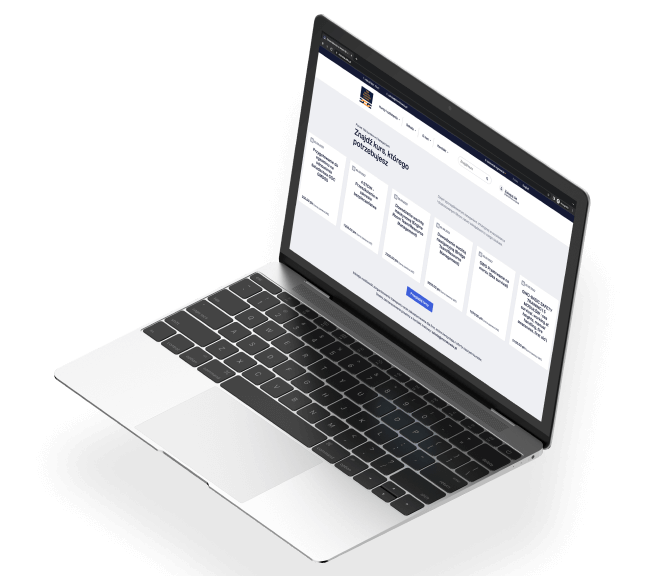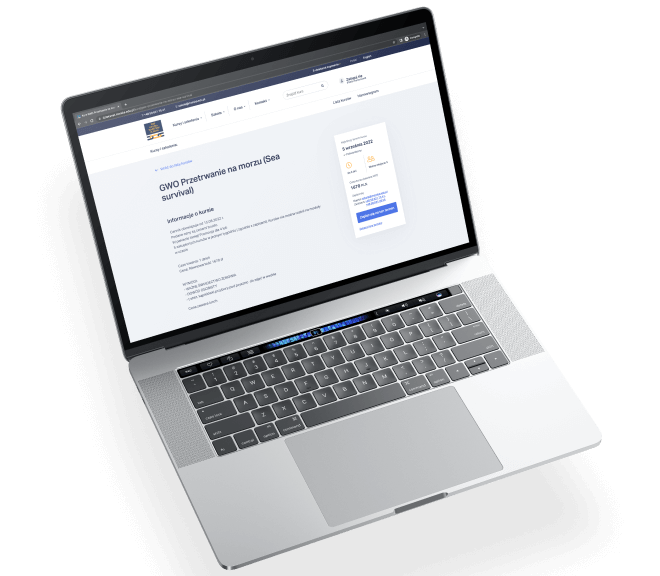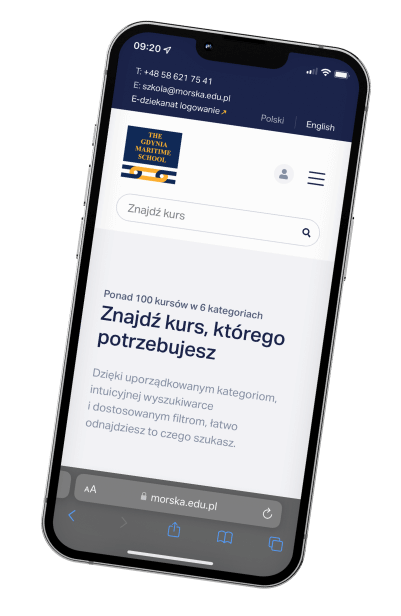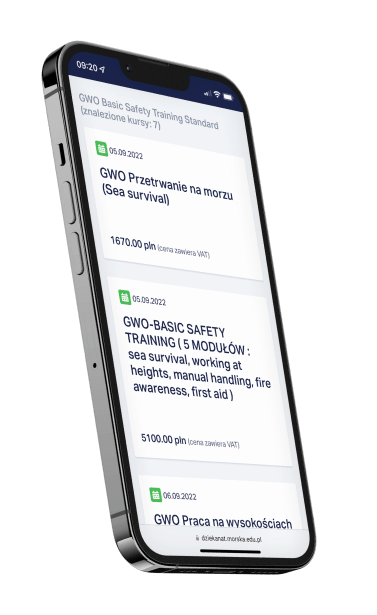Home » The Gdynia Maritime School
Case study
Find out how we help companies. Discover selected projects.
The Gdynia Maritime School

COMPANY
The Gdynia Maritime School
Established in 1998, The Gdynia Maritime School is a company that runs a non-public Post-Secondary Maritime School educating in the professions of navigator officer and marine engineer officer, a non-public Educational Institution (Training Centre), training seafarers and officers of sea vessels, maritime economy employees as well as sailors and motor boaters, as well as publishing activity in the field of preparation and issuing scripts and manuals thematically related to the conducted training.
The teaching staff consists of 130 of the best teachers and practitioners in their field. They have many years of experience working on seagoing vessels, including instrumental ones at Gdynia Maritime University, shipping companies and Maritime Administration, and managing facilities.
Our cooperation with the Maritime School began in 2016. Since then, we have been continuously working on developing new applications to support the client’s operations and providing digital marketing services. Recently, a new challenge arose – the modernisation of the previous website and its extension to include a course database with online registration. However, the main goal was to create a comprehensive system that primarily supports administrative work and automates repetitive activities.

Challenge
Nowadays, a website cannot be limited to displaying basic information and providing the necessary content but should also encourage the user to continue browsing while remaining as functional and intuitive as possible. In the era of instant access to information, the 21st-century Internet user expects the same reliable experience when visiting a school or university website.
An attractive and ergonomic website helps make a favourable first impression on visitors. People who visit a school’s website for the first time only try to find direct and clear information about applying and the education process. If potential students can find everything quickly and clearly – with a logical navigation and link structure – they are likely to come back to start the application procedure.
The needs of the Maritime School were precise – a coherent, comprehensive site that could act as a showcase for the company, be a knowledge base for current and prospective students and support the processing of course applications. At the same time, the site was to be part of a larger system to support the dean’s office and facilitate day-to-day operations.
Currently, course registration in many schools and universities is traditionally done with hand-filled paper applications, and all applications are entered into internal systems. The Maritime School has introduced an online registration system to speed up this process.


Objective
We worked together to create a modern system that:
- is consistent in terms of branding,
- presents information in two languages - Polish and English,
- supports multi-currency transactions,
- allows the creation of a variety of courses with multiple dates,
- presents data related to the activities of the School clearly and transparently,
- allows access to courses from a list or schedule with a calendar view,
- allows to group and categorise courses,
- guides users through the course registration process and does it intuitively,
- automates processes related to costs, notifications, generated documents,
- supports the information flow at the user-organisational level,
- supports the activities of administrative staff.
Dedicated team
- Back-end developers,
- Front-end developers,
- UX specialists,
- Analyst,
- Project Manager,
- DevOps specialist.


Workflow
We started work on the project by analysing functional and non-functional needs and requirements to specify the project objectives, and the software development assumptions, identify project risks and choose the technological stack of the system. A detailed pre-implementation analysis and continuous cooperation with the client at all stages of software development ensures that the solution built will meet all agreed requirements and supports the company’s internal processes.
With every project, we strive to understand the future users of the system to understand their needs and expectations better. To do this, we used a design thinking approach, which allowed us to challenge and rebuild previous design assumptions, identify flawed patterns early on and create innovative solutions.
The next stage was to create mock-ups and prototypes of the future system, which were visual guides representing the site’s skeleton, describing its appearance and functions. Our UX specialists designed the layout so that the page became an integral part of the company, and the design met the expectations of the most demanding users.
The client’s involvement in designing and creating the software and effective management of the subsequent stages of system development prepared the company for reliable and effective implementation of the new website and its effective management.
Solution
Today, the effectiveness of a website in attracting potential customers is more important than ever. An increasing percentage of customers use a website as their first point of contact with a company. A positive first impression is crucial to building long-term customer relationships and developing brand loyalty. For this reason, the new system had to be intuitive to manage, allow easy editing of published pages, and support the processing of student data so that the published content, layout, and features could be freely developed and adapted to specific user requirements.
Improving the UX and introducing a modern while simultaneously harmonising with the brand’s character design, adapted to mobile devices, significantly increased the attractiveness of the presented content. Easy access to information, simple navigation, dynamic, large-format photos and videos, and selected content ensured the highest level of user experience, meeting the needs of even the most demanding users. On the other hand, the site’s bilingual nature helped broaden the audience network, positively impacting the site’s traffic and building relationships with new audiences.


The implementation of the online registration system aimed to introduce consistency in multi-channel communication and streamline the processing of applications by minimising the need for manual handling of forms. By streamlining, automating and modernising processes, the system has moved away from inefficient communication methods such as text messages and phone calls, improving efficiency and the quality of service provided.
The electronic registration system provided access to courses from anywhere in the world and allowed easy selection of training at a time convenient to the user. Enhanced administrative functions have improved the management of decisions regarding the offer of courses, and the process of planning them has become more convenient and easier to achieve. All these activities were aimed at reaching new audiences – potential students.
The online registration system also supports the daily activities of the Maritime School administration. Access to detailed data, an extensive system of automatic notifications and the ability to generate various documents (such as certificates, attendance logs, etc.), reduce the number of daily necessary repetitive activities carried out by staff. With the traditional paper-based method, it took a lot of work for recruitment organisers to estimate the number of course users accurately. In the developed system, the database updates automatically, allowing organisers to control limits in real-time. Eliminating the need to open, enter and archive illegible or inaccurate paper forms has made managing applications much easier for the Maritime School administration.
With the complete registration system, the client has been given the ability to collect participant information in a single, aggregated portal, monitor the registration process by viewing the status of the application (registered, paid, confirmed, etc.) and perform all administrative work related to participants in the same system.
The system’s new, expanded features and the introduction of a modern design have not only made the system more attractive but also more efficient, which has undoubtedly translated into brand recognition, improved work efficiency and business scaling. A clearly defined plan, mutual commitment and regular contact with the client allowed us to achieve all the objectives set at the beginning of the cooperation.




